Lake Baikal Made by Elzova Julia

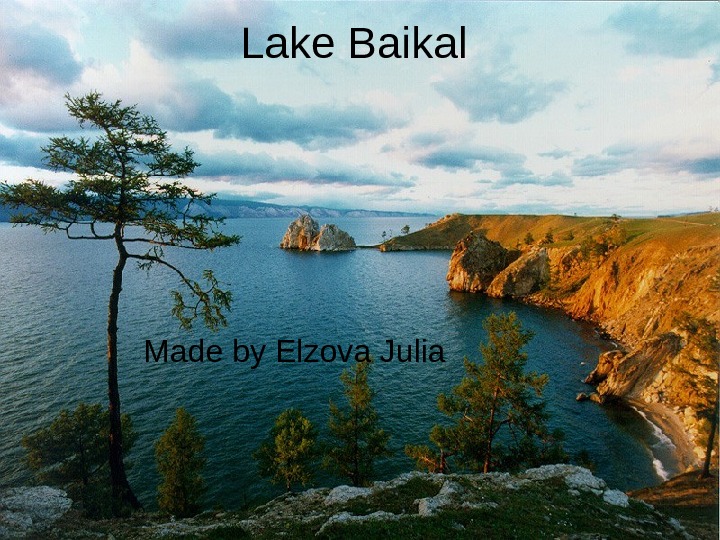
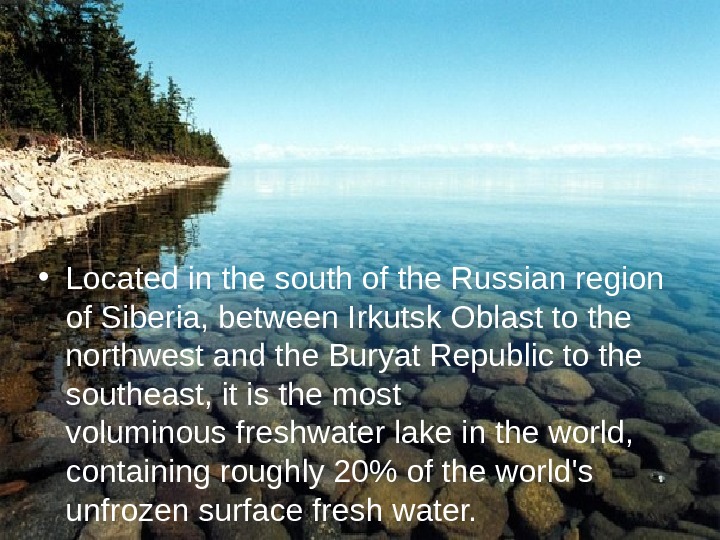

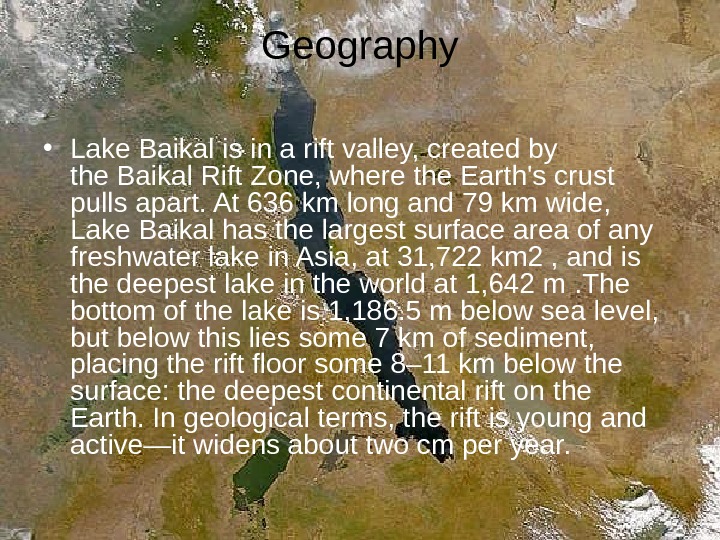

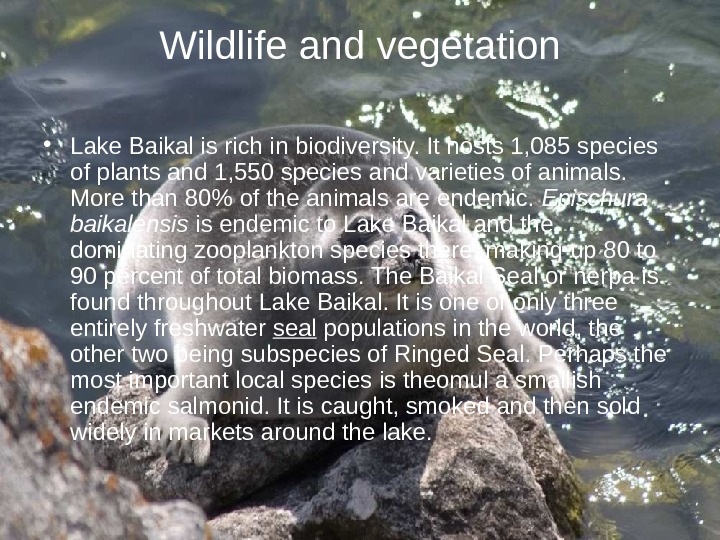

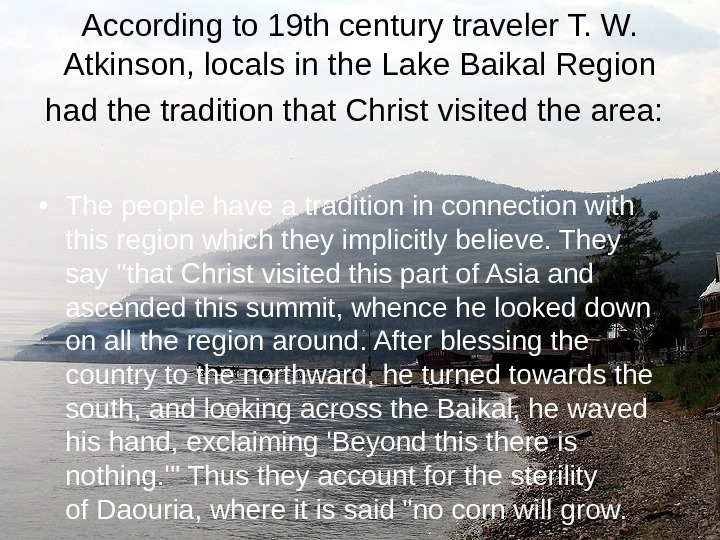
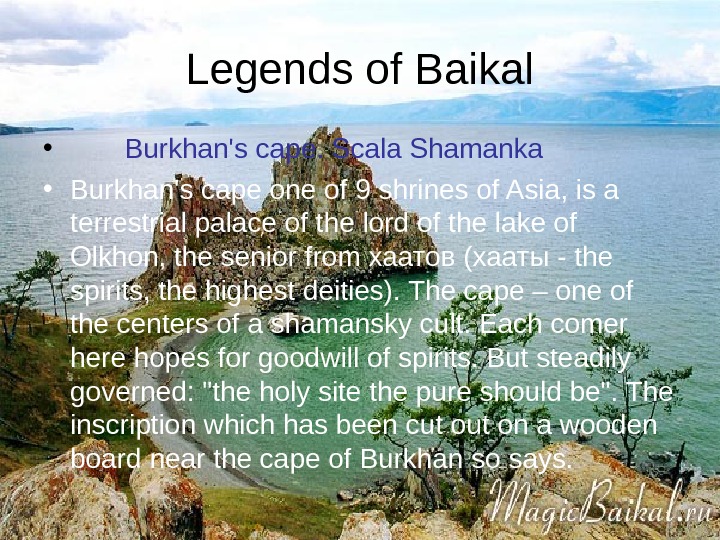
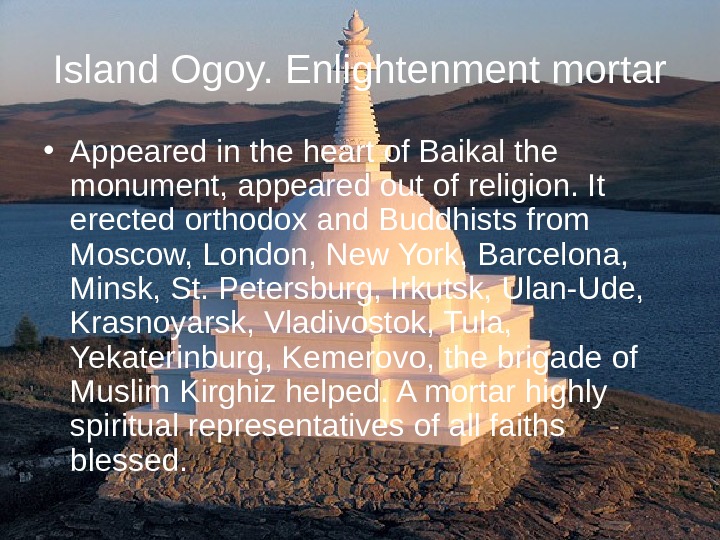
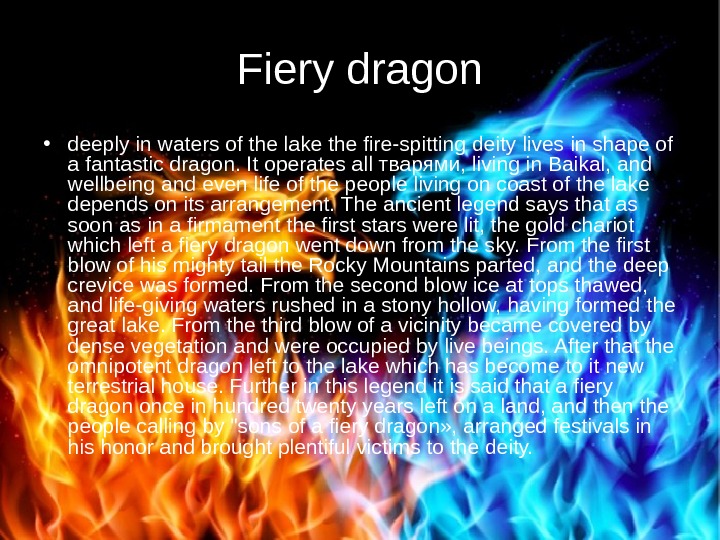
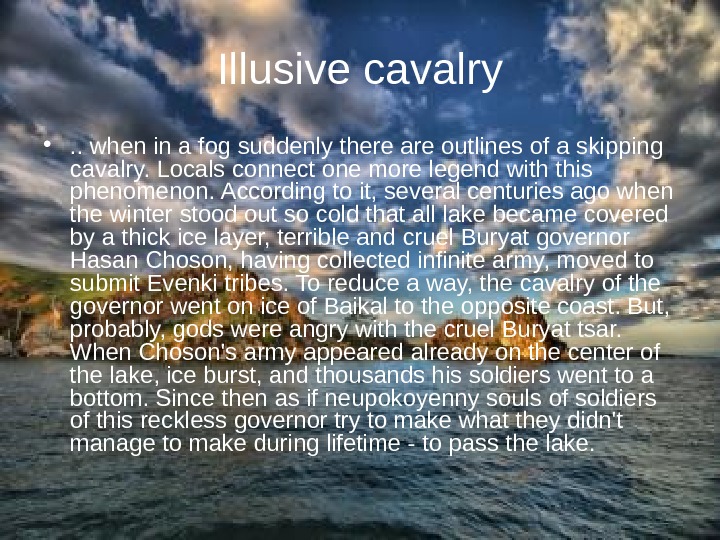
- Размер: 1.4 Mегабайта
- Количество слайдов: 12
Описание презентации Lake Baikal Made by Elzova Julia по слайдам
 Lake Baikal Made by Elzova Julia
Lake Baikal Made by Elzova Julia
 • Located in the south of the Russian region of Siberia, between Irkutsk Oblast to the northwest and the Buryat Republic to the southeast, it is the most voluminous freshwater lake in the world, containing roughly 20% of the world’s unfrozen surface fresh water.
• Located in the south of the Russian region of Siberia, between Irkutsk Oblast to the northwest and the Buryat Republic to the southeast, it is the most voluminous freshwater lake in the world, containing roughly 20% of the world’s unfrozen surface fresh water.
 History • Lake Baikal was known as the «North Sea» in historical Chinese texts. It was situated in then Xiongnu territory that stretched from the empire of the Han Dynasty in the south, to the Siberian taiga north of the lake, and saw military excursions led by the army of the Han Dynasty engaging the Xiongnu during the Han-Hun Wars. Little was known to Europeans about the lake until Russia expanded into the area in the 17 th century. The first Russian explorer to reach Lake Baikal was Kurbat Ivanov in 1643.
History • Lake Baikal was known as the «North Sea» in historical Chinese texts. It was situated in then Xiongnu territory that stretched from the empire of the Han Dynasty in the south, to the Siberian taiga north of the lake, and saw military excursions led by the army of the Han Dynasty engaging the Xiongnu during the Han-Hun Wars. Little was known to Europeans about the lake until Russia expanded into the area in the 17 th century. The first Russian explorer to reach Lake Baikal was Kurbat Ivanov in 1643.
 Geography • Lake Baikal is in a rift valley, created by the Baikal Rift Zone, where the Earth’s crust pulls apart. At 636 km long and 79 km wide, Lake Baikal has the largest surface area of any freshwater lake in Asia , at 31, 722 km 2 , and is the deepest lake in the world at 1, 642 m . The bottom of the lake is 1, 186. 5 m below sea level, but below this lies some 7 km of sediment, placing the rift floor some 8– 11 km below the surface: the deepest continental rift on the Earth. In geological terms, the rift is young and active—it widens about two cm per year.
Geography • Lake Baikal is in a rift valley, created by the Baikal Rift Zone, where the Earth’s crust pulls apart. At 636 km long and 79 km wide, Lake Baikal has the largest surface area of any freshwater lake in Asia , at 31, 722 km 2 , and is the deepest lake in the world at 1, 642 m . The bottom of the lake is 1, 186. 5 m below sea level, but below this lies some 7 km of sediment, placing the rift floor some 8– 11 km below the surface: the deepest continental rift on the Earth. In geological terms, the rift is young and active—it widens about two cm per year.
 • The lake is completely surrounded by mountains. The Baikal Mountains on the north shore and the taiga are technically protected as a national park. It contains 27 islands; the largest, Olkhon, is 72 km long and is the third-largest lake-bound island in the world. The lake is fed by as many as three hundred and thirty inflowing rivers. The main ones draining directly into Baikal are the Selenga River, the Barguzin River, the Upper Angara River, the Turka River, the Sarma River and the Snezhnaya River. It is drained through a single outlet, the Angara River.
• The lake is completely surrounded by mountains. The Baikal Mountains on the north shore and the taiga are technically protected as a national park. It contains 27 islands; the largest, Olkhon, is 72 km long and is the third-largest lake-bound island in the world. The lake is fed by as many as three hundred and thirty inflowing rivers. The main ones draining directly into Baikal are the Selenga River, the Barguzin River, the Upper Angara River, the Turka River, the Sarma River and the Snezhnaya River. It is drained through a single outlet, the Angara River.
 Wildlife and vegetation • Lake Baikal is rich in biodiversity. It hosts 1, 085 species of plants and 1, 550 species and varieties of animals. More than 80% of the animals are endemic. Epischura baikalensis is endemic to Lake Baikal and the dominating zooplankton species there, making up 80 to 90 percent of total biomass. The Baikal Seal or nerpa is found throughout Lake Baikal. It is one of only three entirely freshwater seal populations in the world, the other two being subspecies of Ringed Seal. Perhaps the most important local species is theomul a smallish endemic salmonid. It is caught, smoked and then sold widely in markets around the lake.
Wildlife and vegetation • Lake Baikal is rich in biodiversity. It hosts 1, 085 species of plants and 1, 550 species and varieties of animals. More than 80% of the animals are endemic. Epischura baikalensis is endemic to Lake Baikal and the dominating zooplankton species there, making up 80 to 90 percent of total biomass. The Baikal Seal or nerpa is found throughout Lake Baikal. It is one of only three entirely freshwater seal populations in the world, the other two being subspecies of Ringed Seal. Perhaps the most important local species is theomul a smallish endemic salmonid. It is caught, smoked and then sold widely in markets around the lake.
 Historical traditions • The first European to reach the lake is said to be Kurbat Ivanov in 1643. • In the past, the Baikal was respectfully referred to by many Russians as the «Baikal Sea» (Russian: Море Байкал, More Baikal ), rather than merely «Lake Baikal» This usage is attested already on the late-17 th century maps by. Semyon Remezov. To these days, the strait between the western shore of the Lake and the Olkhon Island is called Maloye More (Малое Море), i. e. «the Little Sea».
Historical traditions • The first European to reach the lake is said to be Kurbat Ivanov in 1643. • In the past, the Baikal was respectfully referred to by many Russians as the «Baikal Sea» (Russian: Море Байкал, More Baikal ), rather than merely «Lake Baikal» This usage is attested already on the late-17 th century maps by. Semyon Remezov. To these days, the strait between the western shore of the Lake and the Olkhon Island is called Maloye More (Малое Море), i. e. «the Little Sea».
 According to 19 th century traveler T. W. Atkinson, locals in the Lake Baikal Region had the tradition that Christ visited the area: • The people have a tradition in connection with this region which they implicitly believe. They say «that Christ visited this part of Asia and ascended this summit, whence he looked down on all the region around. After blessing the country to the northward, he turned towards the south, and looking across the Baikal, he waved his hand, exclaiming ‘Beyond this there is nothing. ‘» Thus they account for the sterility of Daouria, where it is said «no corn will grow.
According to 19 th century traveler T. W. Atkinson, locals in the Lake Baikal Region had the tradition that Christ visited the area: • The people have a tradition in connection with this region which they implicitly believe. They say «that Christ visited this part of Asia and ascended this summit, whence he looked down on all the region around. After blessing the country to the northward, he turned towards the south, and looking across the Baikal, he waved his hand, exclaiming ‘Beyond this there is nothing. ‘» Thus they account for the sterility of Daouria, where it is said «no corn will grow.
 L egends of Baikal • Burkhan’s cape. Scala Shamanka • Burkhan’s cape one of 9 shrines of Asia, is a terrestrial palace of the lord of the lake of Olkhon, the senior from хаатов (хааты — the spirits, the highest deities). The cape – one of the centers of a shamansky cult. Each comer here hopes for goodwill of spirits. But steadily governed: «the holy site the pure should be». The inscription which has been cut on a wooden board near the cape of Burkhan so says.
L egends of Baikal • Burkhan’s cape. Scala Shamanka • Burkhan’s cape one of 9 shrines of Asia, is a terrestrial palace of the lord of the lake of Olkhon, the senior from хаатов (хааты — the spirits, the highest deities). The cape – one of the centers of a shamansky cult. Each comer here hopes for goodwill of spirits. But steadily governed: «the holy site the pure should be». The inscription which has been cut on a wooden board near the cape of Burkhan so says.
 Island Ogoy. Enlightenment mortar • Appeared in the heart of Baikal the monument, appeared out of religion. It erected orthodox and Buddhists from Moscow, London, New York, Barcelona, Minsk, St. Petersburg, Irkutsk, Ulan-Ude, Krasnoyarsk, Vladivostok, Tula, Yekaterinburg, Kemerovo, the brigade of Muslim Kirghiz helped. A mortar highly spiritual representatives of all faiths blessed.
Island Ogoy. Enlightenment mortar • Appeared in the heart of Baikal the monument, appeared out of religion. It erected orthodox and Buddhists from Moscow, London, New York, Barcelona, Minsk, St. Petersburg, Irkutsk, Ulan-Ude, Krasnoyarsk, Vladivostok, Tula, Yekaterinburg, Kemerovo, the brigade of Muslim Kirghiz helped. A mortar highly spiritual representatives of all faiths blessed.
 Fiery dragon • deeply in waters of the lake the fire-spitting deity lives in shape of a fantastic dragon. It operates all тварями, living in Baikal, and wellbeing and even life of the people living on coast of the lake depends on its arrangement. The ancient legend says that as soon as in a firmament the first stars were lit, the gold chariot which left a fiery dragon went down from the sky. From the first blow of his mighty tail the Rocky Mountains parted, and the deep crevice was formed. From the second blow ice at tops thawed, and life-giving waters rushed in a stony hollow, having formed the great lake. From the third blow of a vicinity became covered by dense vegetation and were occupied by live beings. After that the omnipotent dragon left to the lake which has become to it new terrestrial house. Further in this legend it is said that a fiery dragon once in hundred twenty years left on a land, and then the people calling by «sons of a fiery dragon» , arranged festivals in his honor and brought plentiful victims to the deity.
Fiery dragon • deeply in waters of the lake the fire-spitting deity lives in shape of a fantastic dragon. It operates all тварями, living in Baikal, and wellbeing and even life of the people living on coast of the lake depends on its arrangement. The ancient legend says that as soon as in a firmament the first stars were lit, the gold chariot which left a fiery dragon went down from the sky. From the first blow of his mighty tail the Rocky Mountains parted, and the deep crevice was formed. From the second blow ice at tops thawed, and life-giving waters rushed in a stony hollow, having formed the great lake. From the third blow of a vicinity became covered by dense vegetation and were occupied by live beings. After that the omnipotent dragon left to the lake which has become to it new terrestrial house. Further in this legend it is said that a fiery dragon once in hundred twenty years left on a land, and then the people calling by «sons of a fiery dragon» , arranged festivals in his honor and brought plentiful victims to the deity.
 Illusive cavalry • . . when in a fog suddenly there are outlines of a skipping cavalry. Locals connect one more legend with this phenomenon. According to it, several centuries ago when the winter stood out so cold that all lake became covered by a thick ice layer, terrible and cruel Buryat governor Hasan Choson, having collected infinite army, moved to submit Evenki tribes. To reduce a way, the cavalry of the governor went on ice of Baikal to the opposite coast. But, probably, gods were angry with the cruel Buryat tsar. When Choson’s army appeared already on the center of the lake, ice burst, and thousands his soldiers went to a bottom. Since then as if neupokoyenny souls of soldiers of this reckless governor try to make what they didn’t manage to make during lifetime — to pass the lake.
Illusive cavalry • . . when in a fog suddenly there are outlines of a skipping cavalry. Locals connect one more legend with this phenomenon. According to it, several centuries ago when the winter stood out so cold that all lake became covered by a thick ice layer, terrible and cruel Buryat governor Hasan Choson, having collected infinite army, moved to submit Evenki tribes. To reduce a way, the cavalry of the governor went on ice of Baikal to the opposite coast. But, probably, gods were angry with the cruel Buryat tsar. When Choson’s army appeared already on the center of the lake, ice burst, and thousands his soldiers went to a bottom. Since then as if neupokoyenny souls of soldiers of this reckless governor try to make what they didn’t manage to make during lifetime — to pass the lake.

